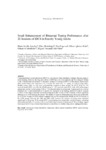Mostrar o rexistro simple do ítem
Small Enhancement of Bimanual Typing Performance after 20 Sessions of tDCS in Healthy Young Adults
| dc.contributor.author | Sevilla-Sánchez, Marta | |
| dc.contributor.author | Hortobágyi, Tibor | |
| dc.contributor.author | Fogelson, Noa | |
| dc.contributor.author | Iglesias-Soler, Eliseo | |
| dc.contributor.author | Carballeira, Eduardo | |
| dc.contributor.author | Fernández-del-Olmo, Miguel | |
| dc.date.accessioned | 2021-10-01T12:12:20Z | |
| dc.date.issued | 2021-05-08 | |
| dc.identifier.citation | Marta Sevilla-Sanchez, Tibor Hortobágyi, Noa Fogelson, Eliseo Iglesias-Soler, Eduardo Carballeira, Miguel Fernandez-del-Olmo, Small Enhancement of Bimanual Typing Performance after 20 Sessions of tDCS in Healthy Young Adults, Neuroscience, Volume 466, 2021, Pages 26-35, ISSN 0306-4522, https://doi.org/10.1016/j.neuroscience.2021.05.001. (https://www.sciencedirect.com/science/article/pii/S0306452221002402) | es_ES |
| dc.identifier.issn | 0306-4522 | |
| dc.identifier.uri | http://hdl.handle.net/2183/28552 | |
| dc.description.abstract | [Abstract] Transcranial direct current stimulation (tDCS) is a non-invasive brain stimulation technique that may improve motor learning. However, the long-term effects of tDCS have not been explored, and the ecological validity of the evaluated tasks was limited. To determine whether 20 sessions of tDCS over the primary motor cortex (M1) would enhance the performance of a complex life motor skill, i.e., typing, in healthy young adults. Healthy young adults (n = 60) were semi-randomly assigned to three groups: the tDCS group (n = 20) received anodal tDCS over M1; the SHAM group (n = 20) received sham tDCS, both while performing a typing task; and the Control group (CON, n = 20) only performed the typing task. Typing speed and errors at maximum (mTT) and submaximal (iTT) speeds were measured before training, and after 10 and 20 sessions of tDCS. Every subject increased maximum typing speed after 10 and 20 tDCS sessions, with no significant differences (p > 0.05) between the groups. The number of errors at submaximal rates decreased significantly (p < 0.05) by 4% after 10 tDCS sessions compared with the 3% increase in the SHAM and the 2% increase in the CON groups. Between the 10th and 20th tDCS sessions, the number of typing errors increased significantly in all groups. While anodal tDCS reduced typing errors marginally, such performance-enhancing effects plateaued after 10 sessions without any further improvements in typing speed. These findings suggest that long-term tDCS may not have functionally relevant effects on healthy young adults’ typing performance. | es_ES |
| dc.description.sponsorship | This work was supported by an ‘FPU’ predoctoral grant from the Spanish ‘Ministerio de Ciencia, Innovación y Universidades’ (FPU16/01264) to Marta Sevilla-Sanchez, ‘Ramón y Cajal’ national fellowship program to Noa Fogelson and a project grant funded by ‘Rey Juan Carlos’ University (REtDCS) to Miguel Fernandez-del-Olmo. | es_ES |
| dc.language.iso | eng | es_ES |
| dc.publisher | Elsevier | es_ES |
| dc.relation | info:eu-repo/grantAgreement/MECD/Plan Estatal de Investigación Científica y Técnica y de Innovación 2013-2016/FPU16%2F01264/ES/ | |
| dc.relation.uri | https://doi.org/10.1016/j.neuroscience.2021.05.001 | es_ES |
| dc.rights | Atribución-NoComercial-SinDerivadas 4.0 Internacional | es_ES |
| dc.rights.uri | http://creativecommons.org/licenses/by-nc-nd/4.0/ | * |
| dc.subject | Non-invasive brain stimulation | es_ES |
| dc.subject | Transcranial direct current stimulation (tDCS) | es_ES |
| dc.subject | Motor learning | es_ES |
| dc.subject | Long-termmotor skills | es_ES |
| dc.title | Small Enhancement of Bimanual Typing Performance after 20 Sessions of tDCS in Healthy Young Adults | es_ES |
| dc.type | info:eu-repo/semantics/article | es_ES |
| dc.rights.access | info:eu-repo/semantics/embargoedAccess | es_ES |
| dc.date.embargoEndDate | 2022-05-08 | es_ES |
| dc.date.embargoLift | 2022-05-08 | |
| UDC.journalTitle | Neuroscience | es_ES |
| UDC.volume | 466 | es_ES |
| UDC.startPage | 26 | es_ES |
| UDC.endPage | 35 | es_ES |
| dc.identifier.doi | 10.1016/j.neuroscience.2021.05.001 |
Ficheiros no ítem
Este ítem aparece na(s) seguinte(s) colección(s)
-
GI-GIGG - Artigos [113]






